
 |
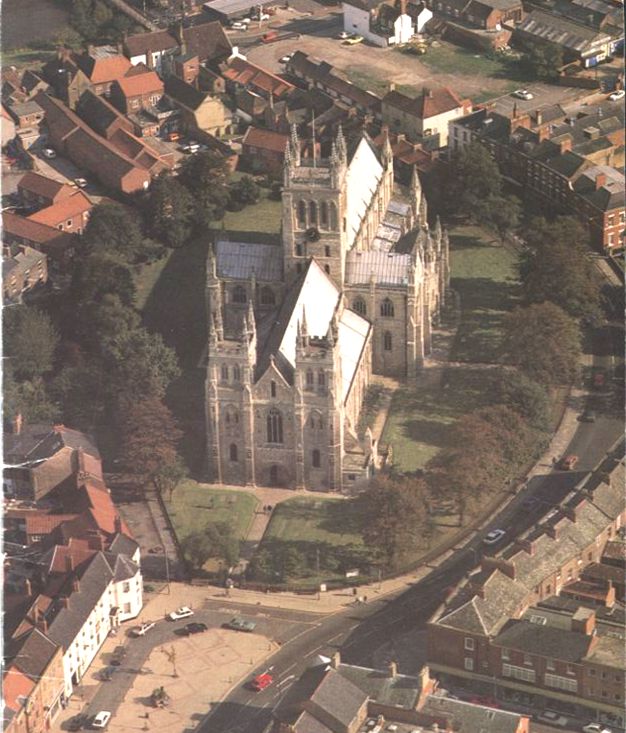
The foundation of Selby Abbey is said to be dated about the year AD 978 when King William the Conqueror granted a charter of land to Benedict, a visionary monk, on which to build a wooden Abbey. In 1069 Benedict was ordained the first abbot of Selby. His successor, Hugh, decided to reconstruct the abbey in stone and much of the building was completed in his lifetime. Further developments took place throught the 13th and 14th century, from which time the interior of the abbey would have looked very much as it does today. Selby Abbey has since survived fire and flood, sinking foundations and falling towers; vandalism by Henry VIII, Charles I and Oliver Cromwell. It has stood through centuries of political and religious upheaval.
Selby is traditionally a centre of local agriculture and the River Ouse and tranquil Selby canal are reminders of its former position as one of Yorkshire’s busiest trading towns. The second World War brought new activity to the town and surrounding districts by the construction or upgrading of fifteen fully operational military airfields and the influx of probably 30,000 airmen and women.
Selby Abbey had significance to them architecturally and spiritually. To quote the words of 578 Squadron pilot, Flight Lieutenant Vic Ferry DFC ’When returning from a dangerous operation, particularly in the early light of morning and seeing the twin towers of Selby Abbey in the distance, I knew we were safely back and gave thanks to God for this mercy.
Veterans of 578 Squadron Royal Air Force and their successors are proud to have been granted the opportunity to place on record, in this lovely place, the deeds and sacrifices made by their fallen comrades and thank the Parochial Church Council of Selby and the Diocese of York for enabling them to do so.
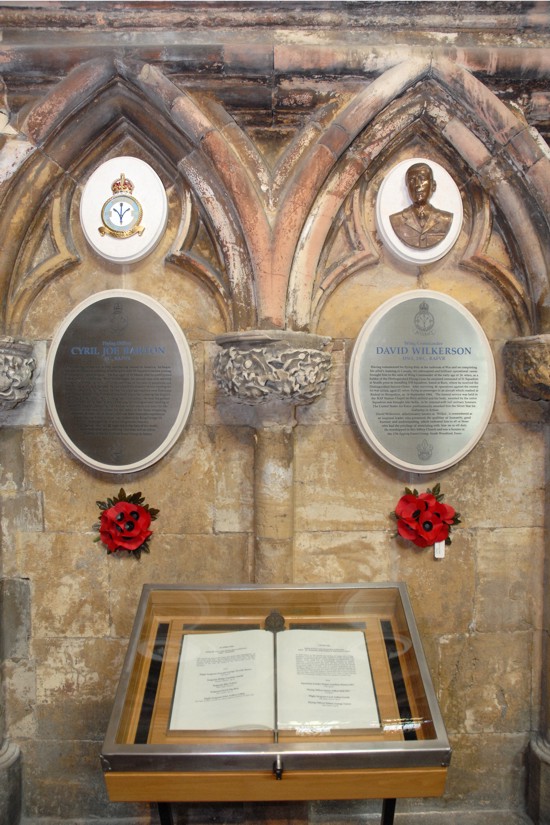
For many years the Association had sought to introduce suitable recognition of two outstanding airmen of 578 Squadron into Selby Abbey, but failed. It was a fortunate coincidence that when Hugh Cawdron presented a copy of his recently published book ‘Based at Burn’ the vicar, the Rev.James Robertson, revealed his connection with the Scout movement and offered support his design and application for a Faculty, which was granted to him by the Diocese of York in 1995.
This enabled the work on site to commence in preparation to commence. The medieval walling, columns, tracery and adjacent leper’s squint hole were found to be in a damp and deteriorating condition and appropriate remedial action was required before the new memorials could be installed. Off site, drawings in respect to the two stone plaques and accompanying stainless steel citation plates were sent to specialist craftsmen. The items were assembled and fixed shortly before the 578 Burn Association annual meeting and Service of Remembrance in May 1995. The citations read
Wing Commander
DAVID WILKERSON
DSO DFC RAFVR
Having volunteered for flying duty at the outbreak of War and on completing
his pilot’s training in Canada, his subsequent and brilliant operational career
brought him to the rand of Wing Commander at the early age of 26 when, as a
holder of the Distinguished Flying Cross he assumed command of 51 Squadron
at Snaith prior to founding 578 Squadron, based at Burn, where he received the
Distinguished Service Order. After surviving 46 operations against the enemy,
he was killed, age 27, when flying as a passenger in an aircraft which crashed at
Rednal in Shropshire, on 16 September 1944. The funeral service was held in
the RAF Station Chapel on Burn airfield and his body, escorted by the entire
Squadron was brought into Selby, to be interred with full military honours.
The United States Air Force posthumously awarded him the Silver Star for
Gallantry in Action.
David Wilkerson, affectionately known as ‘Wilkie’, is remembered as
an inspired leader who possessed the qualities of humanity, good
humour and understanding, which endeared him to all of those
who had the privilege of associating with him on or off duty.
He worshipped in this Abbey Church and was a Scouter in
the 17th Epping Forest Group, South Woodford, Essex
Flying Officer
CYRIL JOE BARTON
V C RAFVR
Volunteering for aircrew in 1941 and having trained in America, he began
operational duties as a Halifax bomber pilot with 78 Squadron before joining
578 Squadron, Based at Burn. On the night of 30 March 1944 he participated
in an attack on Nuremburg. Short of the target, his aircraft was very severely
damaged by enemy fighters, which forced three of his crew to parachute out.
Despite this, single handed, he completed his mission before turning for home.
Guided only by the stars, he flew his crippled machine over Germany
and France, only to meet further anti-aircraft fire when crossing the English
Coast near Sunderland. With all engines out of action, he took the gallant
decision to avoid the heavily populated area by making a crash landing at
nearby Ryhope Colliery, an act of heroism which was to cost him his life.
His final words were of concern for the safety of the three remaining
members of crew, all of whom survived their traumatic experience.
A posthumous Victoria Cross was conferred by King George V1
in recognition of most conspicuous bravery.
Cyril, who was 22 years old at the time of his death, was
a dedicated and practising Christian and an active
member of the 1st Oxshott Scout Group in Surrey
These Memorials were dedicated by the Vicar before a large congregation of 578 veterans, their families and local people at a full choral service held in May 1996.
------------
DETAIL: CITATION PLAQUES OF SATIN FINISHED STAINLESS STEEL, INSCRIPTIONS ACID ETCHED, ENAMEL FILLED, BADGES IN RAF BLUE, LETTERING IN BLACK, EACH MOUNTED ON OVAL 20” HIGH 2” THICK LAPINE LIMESTONE BASE WITH QUADRANT MOULDED EDGES : POPPY POSIES COMPLETE THE ARRANGEMENT : DESIGNER AND MAKER, HUGH CAWDRON : STONE MASONARY AND STEEL ETCHING BY SPECIALIST PROVIDERS.
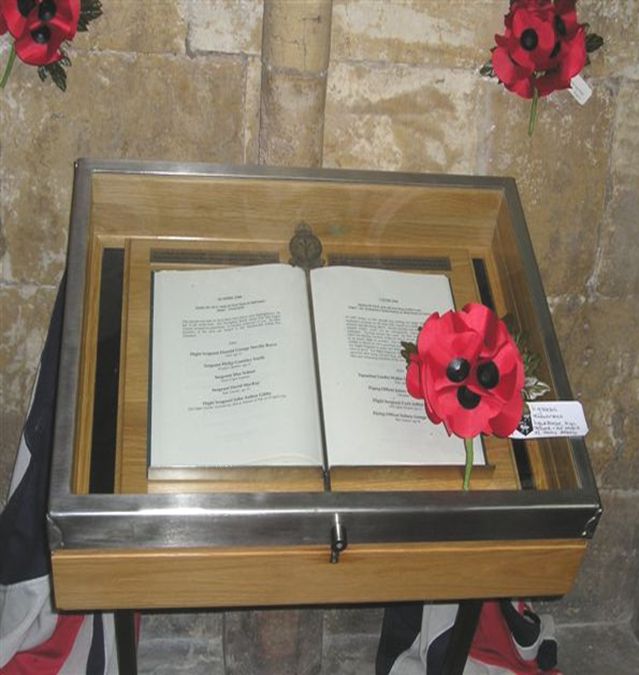
It had always been the intention to supplement the Wilkerson and Barton plaques with a memorial book containing the names and operational particulars of the 219 airmen from 578 Squadron who died on active service. The Abbey staff had reported considerable public interest in the Memorial so far and the position had strengthened by the recent appointment of a new vicar, the Rev. Prebendary Keith Jukes, who encouraged the Parochial Church Council to support this further proposition. Necessary research was started to both establish historical fact and the most appropriate means of displaying it to the visiting public.
Financial constraint dictated the maximum use of freely given amateur resources but without compromising quality. The page sizing was limited to A4 to be within the bounds of domestic word processing equipment but the best enduring velum paper available was selected and used. The first page carried a hand drawn and coloured 578 Squadron badge. Then the introduction PER ARDUA AD ASTRA followed by sixty-two further pages comprising PART ONE : LOSS OF LIFE, giving the name and date of death for each man and PART TWO : LOSS OF AIRCRAFT AND CREW, giving date and time of each Operation, aircraft identity, time of commencement and target, a short account of the operation, rank and name of those killed, their particular task and their age.
Green goat kid leather was selected for the covers and a retired master bookbinder used traditional methods to stitch and embellish it with a gold embossed 578 Squadron badge, edge linings and book marker ribbons. The Squadron badge was impressed in gold leaf, as were the edge linings back and front. The book concluded with the prayer:
We remember, O Lord, in gratitude
all who have died that we might live,
all who endured pain that we might know joy,
all who suffered imprisonment
that we might know freedom.
Turn our deep feeling now into determination’
and our determination into deed,
that as men died for peace,
we may live for peace
for the sake of the Prince of Peace,
even Jesus Christ our Lord.
The book cabinet was purpose designed and made to provide secure containment and slope for unrestricted viewing and ease of access. English Oak was used for the lower sides and again to form the inner lining of the brushed stainless steel hinged and lockable top. The substantial baseboard was covered with black melamine and supports an English Oak platform on which rests the open book, the pages of wich are regularly turned by Abbey vergers. To complete the detailing, a thin stainless steel rod surmounted with the Squadron Badge slots into small brackets top and bottom, to restrain the open pages. Also, along the top in stainless steel is the inscription:
IN GRATITUDE TO ALL AIRMEN AND AIRWOMEN WHO SERVED IN 578 SQUADRON ROYAL AIR FORCE at BURN from JANUARY 1944 to MARCH 1945 AND IN PROUD REMEMBRANCE OF THE 219 MEMBERS OF AIRCREW, NAMED IN THIS BOOK WHO LOST THEIR LIVES. MAY THEY REST IN PEACE
The Book of Remembrance was dedicated by Prebendary Keith Jukes, Vicar of Selby, at a special and inspiring Service of Remembrance held on 3 May 1998 attended by 578 Squadron veterans, their family and friends, the Lord Lieutenant of Selby, civic dignitaries and many from Burn and surrounding areas, a number which filled Nave and Aisles of the Abbey to overflowing. Further support was given by full organ and choir, bell ringing and a Squadron of ATC cadets which provided a Guard of Honour. Among other outstanding contributions on that morning was the reading of the moving poem by J B B Peel ‘Remembrance Day’ by the Commanding Officer of RAF Linton on Ouse and a powerful rendition by Jim Allen DFC former 578 Squadron pilot, of ‘Passing Over’ written by his navigator C J Dudley DFC on Burn airfield. Next of kin and close friends shared in the reading of all 219 names of the fallen.
After the service, most set off for Burn airfield where lunch was served in the Hangar and a full afternoon of aerial and other entertainment enjoyed, many old acquaintances renewed and memories revived.
------------
MEMORIAL BOOK: SIZE 11” HIGH, 9” WIDE: CABINET SIZE: 19” HIGH , 28” WIDE: SUPPORT FRAME: SQUARE STEEL TUBE, WELDED, BLACK ENAMELLED: RESEARCHED, DESIGNED AND MADE: HUGH CAWDRON: BOOKBINDING: VERNON WARD THE ABBEY STAFF REGULARLY TURN THE PAGES AND WILL BE PLEASED TO OPEN THE CABINET TO THE PUBLIC ON REQUEST
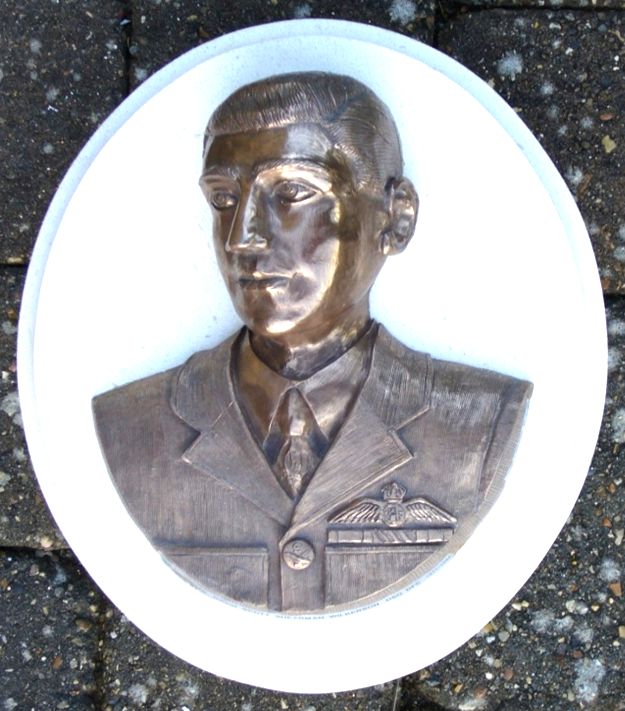
It was logical and desirable that the two vacant tracery cusps above the 578 Squadron Memorial should be occupied, as were the others along the full length of the North Choir Aisle. Enquiries revealed that engraved plaques would be acceptable officially, but, following discussions and presentations, Prebendary Keith Jukes, Vicar of Selby Abbey, who had taken such an active and positive interest in 578 Squadron affairs, accepted that for visual clarity shallow sculpture would be preferable. As he was shortly to depart from the Abbey to take up his appointment as Dean of Ripon Cathedral, early completion of the display was essential. The intention was to display portrait sculpture to match each the memorial plaques below but the Barton family felt unable to participate. The space was filled instead with a Squadron Badge. There was not sufficient time available to cast the sculptures in bronze, therefore a bronze impregnated resin compound was used, left in natural finish for the portrait, and over enamelled for the shield. Mounting for both was bevelled edge Torvoux stone.
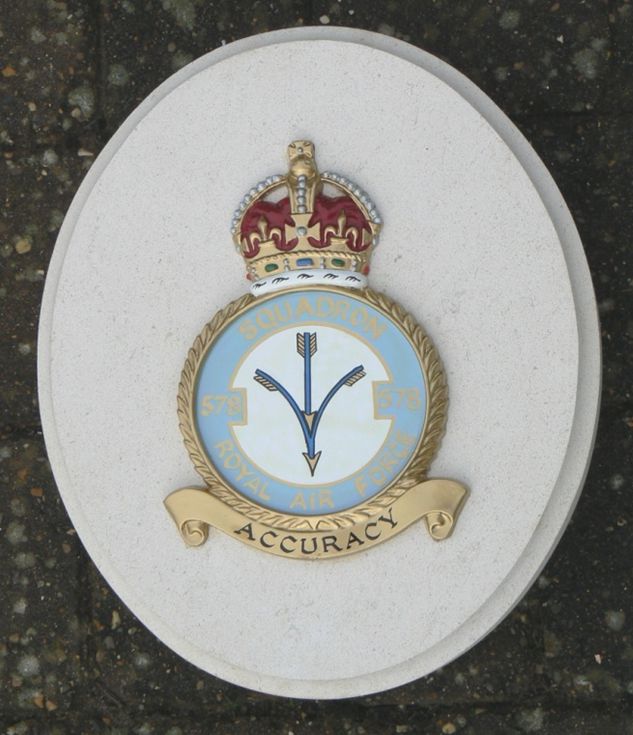
Keith Jukes returned to Selby Abbey in May 2007 to officiate at the final and fully choral Service of Dedication for the completed Memorial. Official representatives were the High Steward of Selby Abbey, Chairmen of North Yorkshire and Selby District Councils the Mayor of Selby and a congregation of Association members, ex service and youth organisations and local people. As previously, 578 Squadron veterans read the names of their 219 airmen colleagues who died on active service for their country.
Thus, after twelve years, the ambition of many 578 Squadron veterans to see their lost wartime comrades permanently honoured in such magnificent surroundings had been achieved.
------------
DESIGN AND SCULPTURE: HUGH CAWDRON:
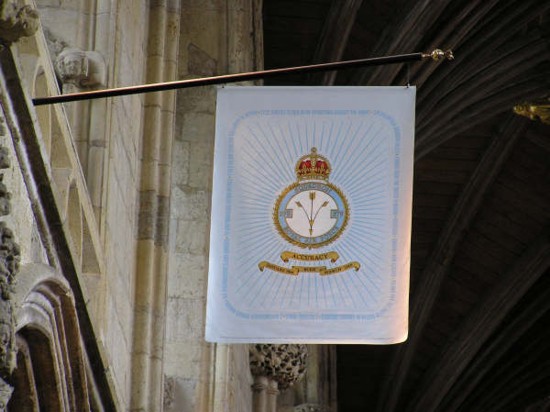
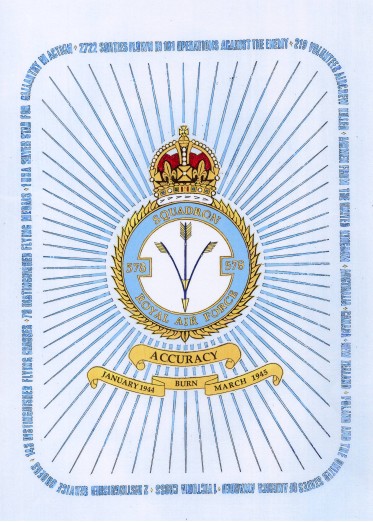
This Standard was dedicated at the 578 Squadron Burn Association Reunion Service of Remembrance on 10 May 2003 and hung on the Cantoris side of the Choir as a match to the 51 Squadron Standard opposite.
The design is intended to convey a resume of Squadron achievement. It comprises the 578 Squadron badge with two base ribbons, bearing the words ‘ACCURACY JANUARY 1944 – BURN - MARCH 1945’ all set on a cerulean blue background. Projecting from this, in darker blue, are tapered radial lines, indicative of compass bearings and pointing to a full border of lettering stating:
2722 SORTIES FLOWN IN 161 OPERATIONS AGAINST THE ENEMY : 219 VOLUNTEER AIRCREW KILLED : AIRMEN FROM THE UNITED KINGDOM : AUSTRALIA : CANADA ; NEW ZEALAND : POLAND AND THE UNITED STATES OF AMERICA AWARDED : 1 VICTORIA CROSS : 2 DISTINGUISHED SERVICE ORDERS : 143 DISTINGUISHED FLYING CROSSES : 73 DISTINGUISHED FLYING MEDALS : 1 USA SILVER STAR FOR GALLANTRY IN ACTION
A footnote on the East side in very small lettering bears the words:
THIS FLAG, DEDICATED TO ALL WHO SERVED IN 578 SQUADRON WAS MADE AND PRESENTED TO SELBY ABBEY BY HUGH CAWDRON IN MEMORY OF HIS FRIEND WING COMMANDER DAVID SCOTT SHEARMAN WILKERSON DSO DFC SILVER STAR (USA) KILLED ON ACTIVE SERVICE 16 SEPTEMBER 1944 AGED 27 YEARS
------------
DETAIL : 48 INCHES HIGH, 32 INCHES WIDE, ACRYLIC PAINTING ON BOTH SIDES OF PRIMED FINE WOVEN COTTON DUCK CANVAS, VARNISHED AND SUSPENDED ON A STEEL STAFF, ENAMELLED BLACK, WITH A POLISHED BRASS BALL AND EAGLE
Click here to return to the list of 578 Squadron memorials